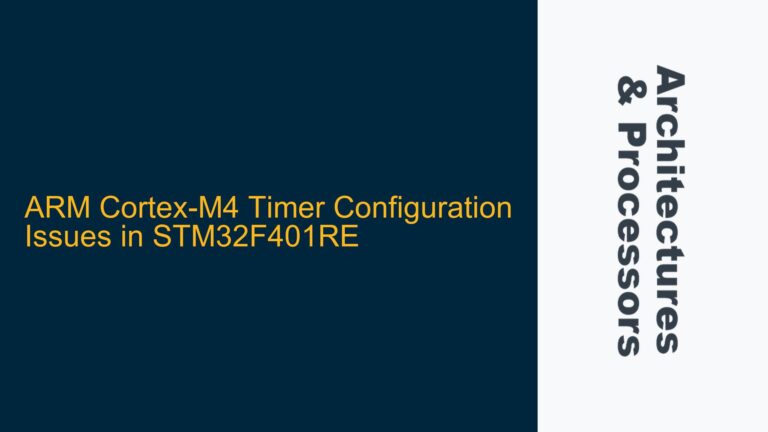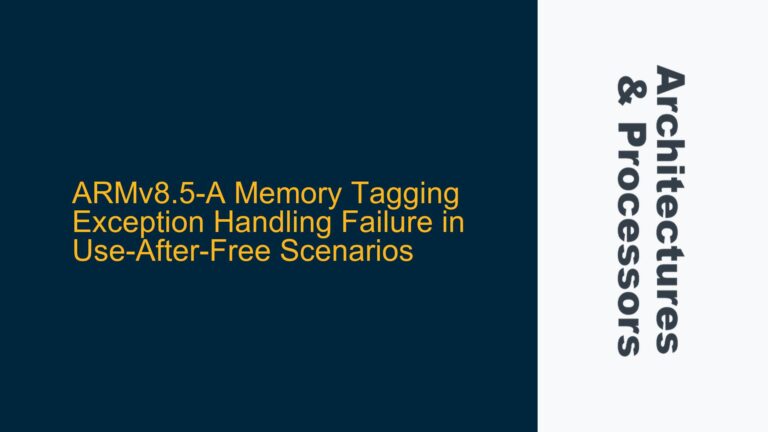ARM Cortex-R52 Architecture and FreeRTOS SMP Compatibility
The ARM Cortex-R52 is a high-performance processor designed for real-time and safety-critical applications, particularly in the automotive and industrial sectors. It features a dual-core configuration with support for symmetric multiprocessing (SMP), making it an ideal candidate for running real-time operating systems (RTOS) like FreeRTOS in SMP mode. However, porting FreeRTOS SMP to the Cortex-R52 presents unique challenges due to the processor’s architectural nuances, including its memory management unit (MMU), cache coherency mechanisms, and interrupt handling capabilities.
The Cortex-R52’s MMU supports virtualization and address translation, which is crucial for running multiple tasks in isolated environments. This feature is particularly important in safety-critical applications where fault isolation is mandatory. The processor also includes a Memory Protection Unit (MPU) that can be used to enforce memory access policies, adding another layer of complexity to the porting process. Additionally, the Cortex-R52’s cache architecture is designed for low-latency access, but it requires careful management to ensure data consistency across cores in an SMP environment.
FreeRTOS SMP, on the other hand, is designed to run on multicore processors with shared memory. It relies on atomic operations and mutual exclusion mechanisms to ensure task synchronization and resource sharing across cores. The challenge lies in adapting FreeRTOS SMP to the Cortex-R52’s specific architectural features, such as its cache coherency protocol and interrupt handling mechanisms. The Cortex-R52 uses the ARMv8-R architecture, which introduces new instructions and features that must be leveraged to achieve optimal performance and reliability.
One of the key considerations when porting FreeRTOS SMP to the Cortex-R52 is the handling of interrupts. The Cortex-R52 supports nested vectored interrupts, which allow high-priority interrupts to preempt lower-priority ones. This feature must be carefully integrated into the FreeRTOS SMP scheduler to ensure that real-time tasks are executed with minimal latency. Additionally, the Cortex-R52’s interrupt controller must be configured to support the specific requirements of FreeRTOS SMP, such as inter-core communication and task migration.
Another critical aspect is the management of shared resources, such as memory and peripherals, across multiple cores. The Cortex-R52’s cache coherency protocol ensures that all cores see a consistent view of memory, but this requires careful configuration of the cache and memory barriers. FreeRTOS SMP must be adapted to use these features effectively to avoid race conditions and ensure data integrity. This includes implementing proper cache invalidation and flush operations when tasks are migrated between cores or when shared data is modified.
In summary, porting FreeRTOS SMP to the ARM Cortex-R52 involves addressing several architectural challenges, including MMU and MPU configuration, cache coherency, interrupt handling, and shared resource management. Each of these areas requires a deep understanding of both the Cortex-R52’s architecture and the FreeRTOS SMP implementation to ensure a successful port.
Memory Management and Cache Coherency in Cortex-R52 SMP Environments
Memory management and cache coherency are two of the most critical aspects to consider when porting FreeRTOS SMP to the ARM Cortex-R52. The Cortex-R52’s MMU and MPU provide robust mechanisms for memory protection and address translation, but they also introduce complexity that must be carefully managed in an SMP environment. The MMU supports multiple address spaces, which can be used to isolate tasks and prevent unauthorized access to critical memory regions. However, this feature must be integrated into the FreeRTOS SMP scheduler to ensure that tasks running on different cores do not interfere with each other.
The Cortex-R52’s cache architecture is designed for low-latency access, but it requires careful management to ensure data consistency across cores. The processor uses a cache coherency protocol that ensures all cores see a consistent view of memory, but this protocol must be properly configured and managed by the operating system. In an SMP environment, tasks running on different cores may access shared data, and it is essential to ensure that changes to this data are propagated correctly across all caches.
One of the key challenges in managing cache coherency in the Cortex-R52 is the use of memory barriers. Memory barriers are instructions that enforce ordering constraints on memory operations, ensuring that certain operations are completed before others begin. In an SMP environment, memory barriers are essential for preventing race conditions and ensuring data integrity. However, the Cortex-R52’s cache coherency protocol introduces additional complexity, as memory barriers must be used in conjunction with cache maintenance operations to ensure that changes to shared data are visible to all cores.
Another important consideration is the use of the Cortex-R52’s MPU to enforce memory access policies. The MPU can be used to define regions of memory that are accessible only to specific tasks or cores, adding another layer of protection to the system. However, the MPU must be carefully configured to ensure that it does not interfere with the operation of FreeRTOS SMP. For example, the MPU must be configured to allow access to shared memory regions that are used for inter-core communication, while still protecting critical system data.
In addition to memory management and cache coherency, the Cortex-R52’s interrupt handling capabilities must also be considered when porting FreeRTOS SMP. The processor supports nested vectored interrupts, which allow high-priority interrupts to preempt lower-priority ones. This feature must be integrated into the FreeRTOS SMP scheduler to ensure that real-time tasks are executed with minimal latency. Additionally, the Cortex-R52’s interrupt controller must be configured to support the specific requirements of FreeRTOS SMP, such as inter-core communication and task migration.
In summary, memory management and cache coherency are critical aspects of porting FreeRTOS SMP to the ARM Cortex-R52. The Cortex-R52’s MMU and MPU provide robust mechanisms for memory protection and address translation, but they must be carefully managed in an SMP environment. The processor’s cache coherency protocol ensures data consistency across cores, but it requires proper configuration and the use of memory barriers. Additionally, the Cortex-R52’s interrupt handling capabilities must be integrated into the FreeRTOS SMP scheduler to ensure real-time performance and reliability.
Implementing FreeRTOS SMP on Cortex-R52: Step-by-Step Guide
Implementing FreeRTOS SMP on the ARM Cortex-R52 involves several steps, each of which must be carefully executed to ensure a successful port. The first step is to configure the Cortex-R52’s MMU and MPU to support the requirements of FreeRTOS SMP. This includes defining memory regions for tasks, shared memory, and system data, and configuring the MMU and MPU to enforce access policies. The MMU must be configured to support address translation and virtualization, while the MPU must be configured to protect critical system data and allow access to shared memory regions.
The next step is to configure the Cortex-R52’s cache coherency protocol to ensure data consistency across cores. This involves setting up the cache maintenance operations and memory barriers that are required to propagate changes to shared data across all caches. The cache coherency protocol must be carefully managed to avoid race conditions and ensure data integrity. This includes implementing proper cache invalidation and flush operations when tasks are migrated between cores or when shared data is modified.
Once the memory management and cache coherency mechanisms are in place, the next step is to integrate the Cortex-R52’s interrupt handling capabilities into the FreeRTOS SMP scheduler. This involves configuring the processor’s interrupt controller to support nested vectored interrupts and inter-core communication. The interrupt controller must be configured to allow high-priority interrupts to preempt lower-priority ones, ensuring that real-time tasks are executed with minimal latency. Additionally, the interrupt controller must be configured to support task migration and inter-core communication, which are essential for the operation of FreeRTOS SMP.
After configuring the interrupt controller, the next step is to implement the FreeRTOS SMP scheduler on the Cortex-R52. This involves adapting the scheduler to support the processor’s architectural features, such as its dual-core configuration and cache coherency protocol. The scheduler must be configured to manage tasks across multiple cores, ensuring that tasks are executed in a timely manner and that shared resources are properly managed. This includes implementing mutual exclusion mechanisms, such as spinlocks and semaphores, to prevent race conditions and ensure data integrity.
The final step is to test and validate the FreeRTOS SMP implementation on the Cortex-R52. This involves running a series of tests to ensure that the operating system is functioning correctly and that all architectural features are being properly utilized. The tests should include stress tests to evaluate the system’s performance under heavy load, as well as functional tests to ensure that all features of FreeRTOS SMP are working as expected. Additionally, the tests should include safety-critical scenarios to ensure that the system meets the requirements of its intended application.
In summary, implementing FreeRTOS SMP on the ARM Cortex-R52 involves several steps, including configuring the MMU and MPU, setting up the cache coherency protocol, integrating the interrupt handling capabilities, implementing the scheduler, and testing and validating the system. Each of these steps must be carefully executed to ensure a successful port and to achieve optimal performance and reliability. By following this step-by-step guide, developers can successfully port FreeRTOS SMP to the Cortex-R52 and leverage its advanced architectural features for real-time and safety-critical applications.






